cylinder SUBARU TRIBECA 2009 1.G Service User Guide
[x] Cancel search | Manufacturer: SUBARU, Model Year: 2009, Model line: TRIBECA, Model: SUBARU TRIBECA 2009 1.GPages: 2453, PDF Size: 46.32 MB
Page 721 of 2453
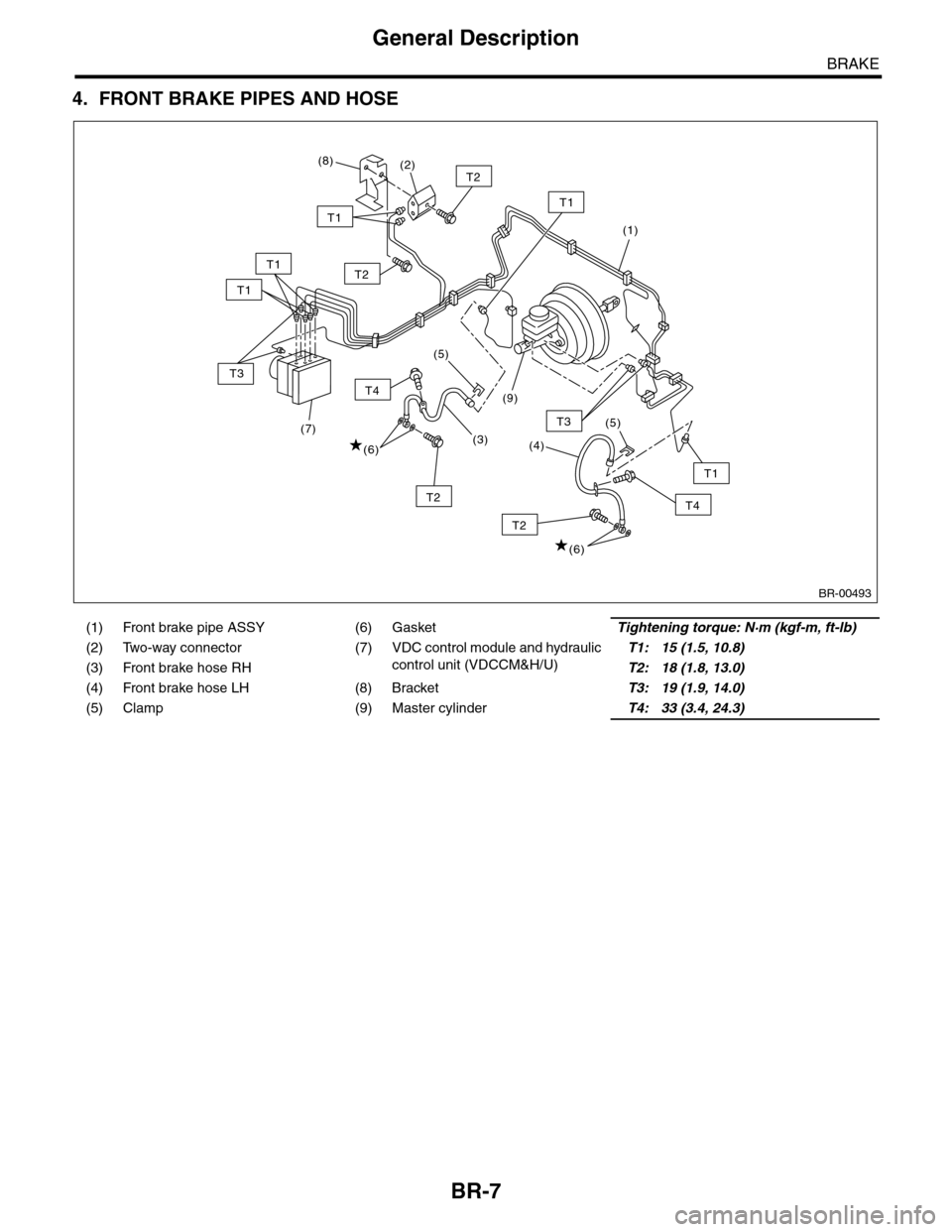
BR-7
General Description
BRAKE
4. FRONT BRAKE PIPES AND HOSE
(1) Front brake pipe ASSY (6) GasketTightening torque: N·m (kgf-m, ft-lb)
(2) Two-way connector (7)
VDC control module and hydraulic
control unit (VDCCM&H/U)
T1: 15 (1.5, 10.8)
(3) Front brake hose RHT2: 18 (1.8, 13.0)
(4) Front brake hose LH (8) BracketT3: 19 (1.9, 14.0)
(5) Clamp (9) Master cylinderT4: 33 (3.4, 24.3)
BR-00493
T1
T2
T4
T2
T2
T2
T4
T1
T3
(8)(2)
(3)
(5)
(6)
(4)
(7)
(6)
(5)
T3
T1
T1
(1)
(9)
T1
Page 731 of 2453
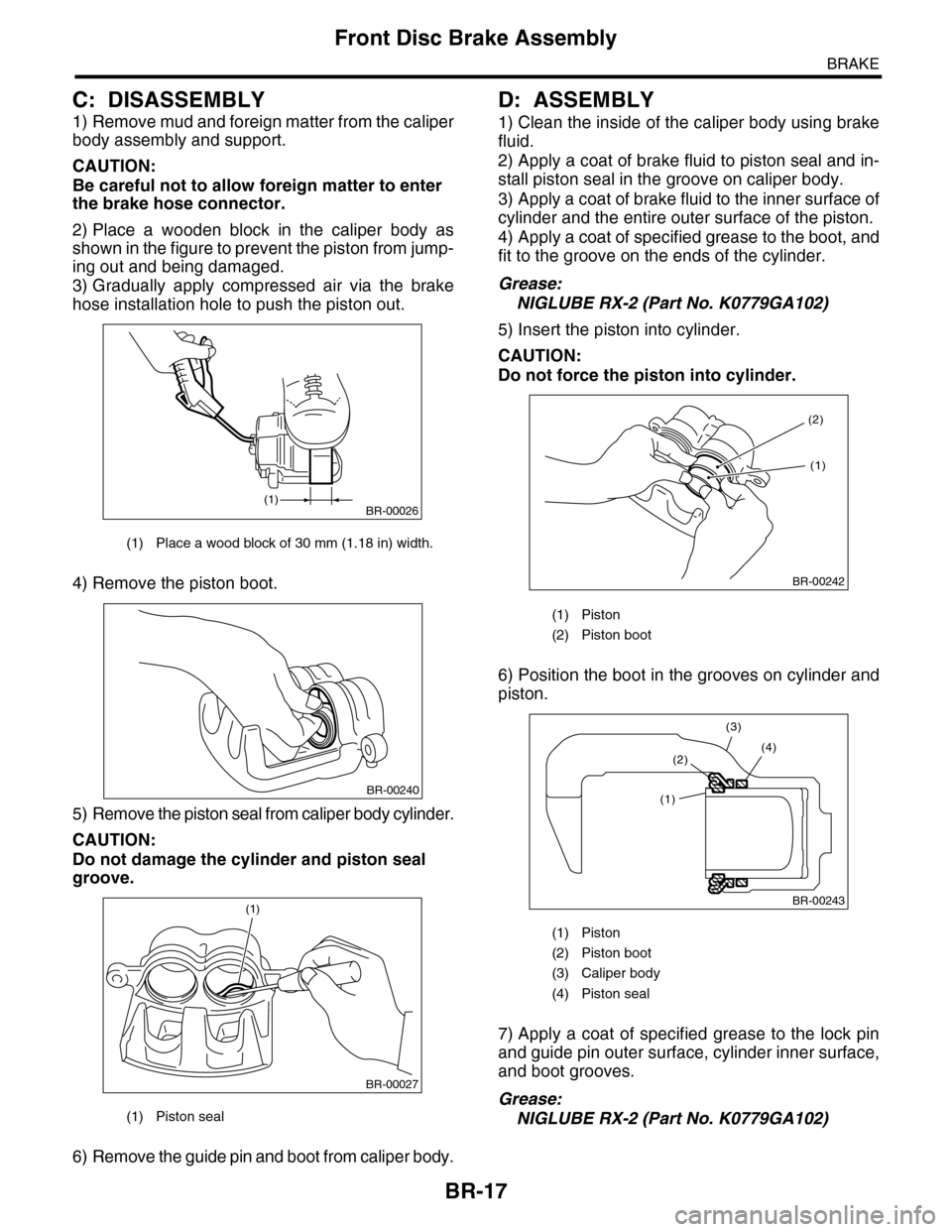
BR-17
Front Disc Brake Assembly
BRAKE
C: DISASSEMBLY
1) Remove mud and foreign matter from the caliper
body assembly and support.
CAUTION:
Be careful not to allow foreign matter to enter
the brake hose connector.
2) Place a wooden block in the caliper body as
shown in the figure to prevent the piston from jump-
ing out and being damaged.
3) Gradually apply compressed air via the brake
hose installation hole to push the piston out.
4) Remove the piston boot.
5) Remove the piston seal from caliper body cylinder.
CAUTION:
Do not damage the cylinder and piston seal
groove.
6) Remove the guide pin and boot from caliper body.
D: ASSEMBLY
1) Clean the inside of the caliper body using brake
fluid.
2) Apply a coat of brake fluid to piston seal and in-
stall piston seal in the groove on caliper body.
3) Apply a coat of brake fluid to the inner surface of
cylinder and the entire outer surface of the piston.
4) Apply a coat of specified grease to the boot, and
fit to the groove on the ends of the cylinder.
Grease:
NIGLUBE RX-2 (Part No. K0779GA102)
5) Insert the piston into cylinder.
CAUTION:
Do not force the piston into cylinder.
6) Position the boot in the grooves on cylinder and
piston.
7) Apply a coat of specified grease to the lock pin
and guide pin outer surface, cylinder inner surface,
and boot grooves.
Grease:
NIGLUBE RX-2 (Part No. K0779GA102)
(1) Place a wood block of 30 mm (1.18 in) width.
(1) Piston seal
(1)BR-00026
BR-00240
(1)
BR-00027
(1) Piston
(2) Piston boot
(1) Piston
(2) Piston boot
(3) Caliper body
(4) Piston seal
BR-00242
(1)
(2)
BR-00243
(1)
(2)
(3)
(4)
Page 737 of 2453
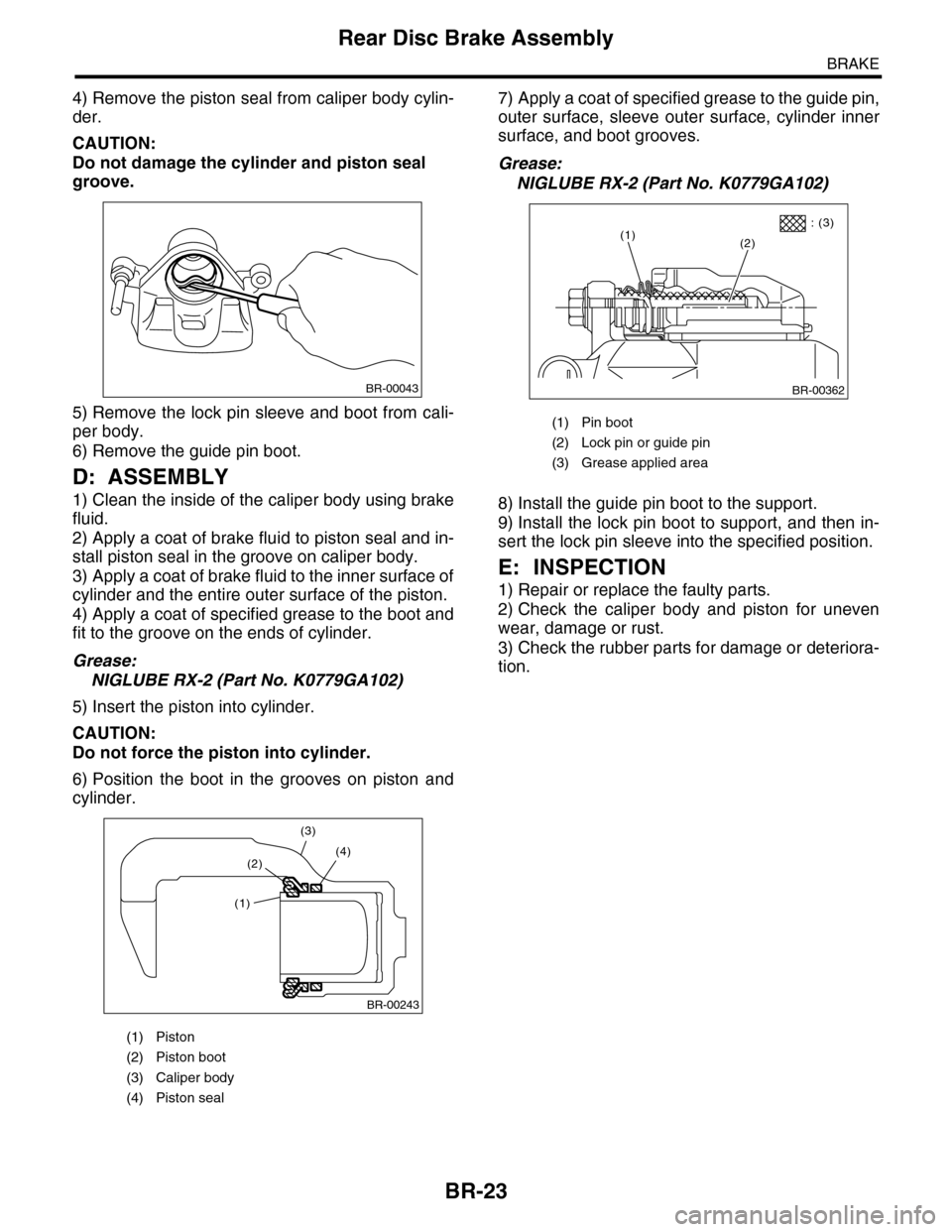
BR-23
Rear Disc Brake Assembly
BRAKE
4) Remove the piston seal from caliper body cylin-
der.
CAUTION:
Do not damage the cylinder and piston seal
groove.
5) Remove the lock pin sleeve and boot from cali-
per body.
6) Remove the guide pin boot.
D: ASSEMBLY
1) Clean the inside of the caliper body using brake
fluid.
2) Apply a coat of brake fluid to piston seal and in-
stall piston seal in the groove on caliper body.
3) Apply a coat of brake fluid to the inner surface of
cylinder and the entire outer surface of the piston.
4) Apply a coat of specified grease to the boot and
fit to the groove on the ends of cylinder.
Grease:
NIGLUBE RX-2 (Part No. K0779GA102)
5) Insert the piston into cylinder.
CAUTION:
Do not force the piston into cylinder.
6) Position the boot in the grooves on piston and
cylinder.
7) Apply a coat of specified grease to the guide pin,
outer surface, sleeve outer surface, cylinder inner
surface, and boot grooves.
Grease:
NIGLUBE RX-2 (Part No. K0779GA102)
8) Install the guide pin boot to the support.
9) Install the lock pin boot to support, and then in-
sert the lock pin sleeve into the specified position.
E: INSPECTION
1) Repair or replace the faulty parts.
2) Check the caliper body and piston for uneven
wear, damage or rust.
3) Check the rubber parts for damage or deteriora-
tion.
(1) Piston
(2) Piston boot
(3) Caliper body
(4) Piston seal
BR-00043
BR-00243
(1)
(2)
(3)
(4)
(1) Pin boot
(2) Lock pin or guide pin
(3) Grease applied area
BR-00362
(1)(2)
: (3)
Page 738 of 2453
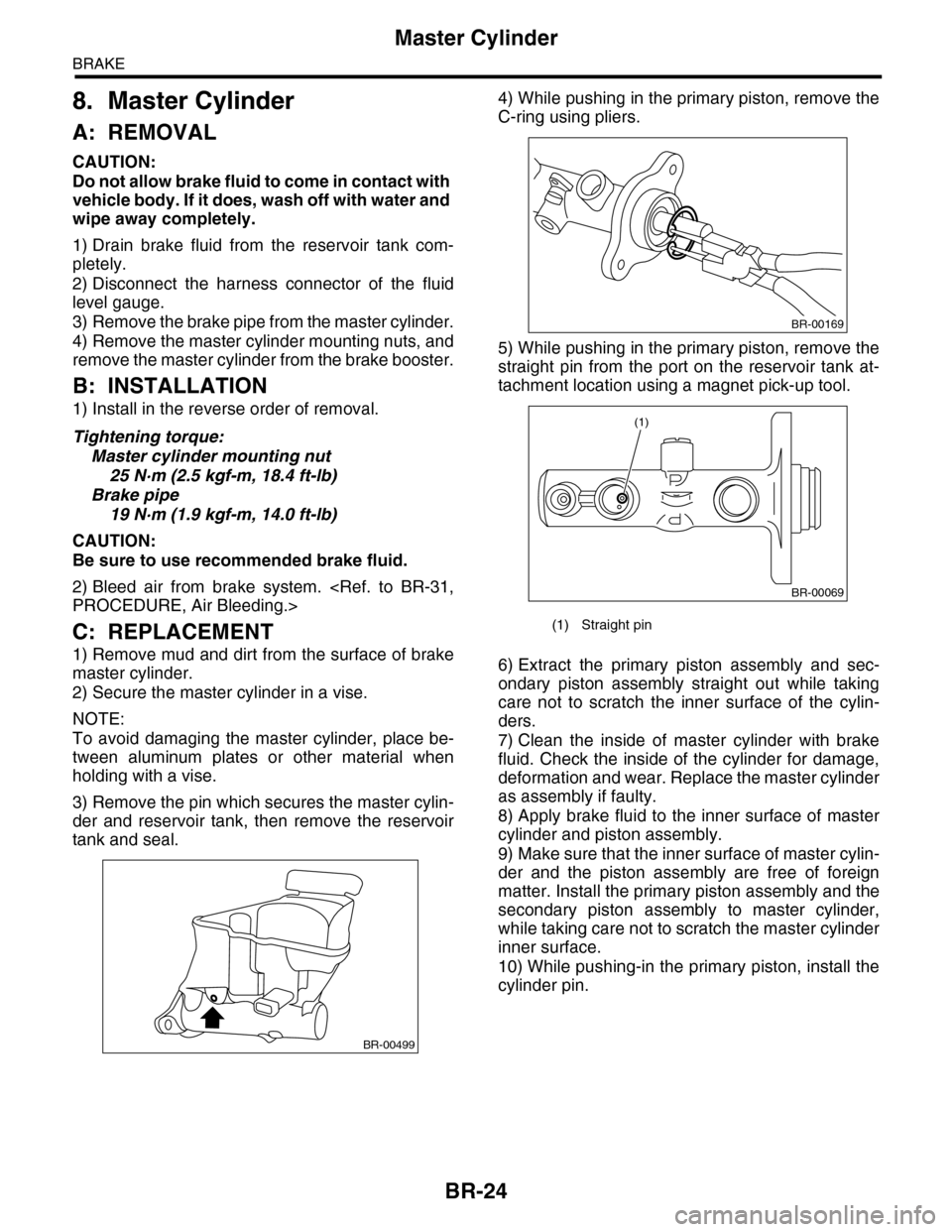
BR-24
Master Cylinder
BRAKE
8. Master Cylinder
A: REMOVAL
CAUTION:
Do not allow brake fluid to come in contact with
vehicle body. If it does, wash off with water and
wipe away completely.
1) Drain brake fluid from the reservoir tank com-
pletely.
2) Disconnect the harness connector of the fluid
level gauge.
3) Remove the brake pipe from the master cylinder.
4) Remove the master cylinder mounting nuts, and
remove the master cylinder from the brake booster.
B: INSTALLATION
1) Install in the reverse order of removal.
Tightening torque:
Master cylinder mounting nut
25 N·m (2.5 kgf-m, 18.4 ft-lb)
Brake pipe
19 N·m (1.9 kgf-m, 14.0 ft-lb)
CAUTION:
Be sure to use recommended brake fluid.
2) Bleed air from brake system.
C: REPLACEMENT
1) Remove mud and dirt from the surface of brake
master cylinder.
2) Secure the master cylinder in a vise.
NOTE:
To avoid damaging the master cylinder, place be-
tween aluminum plates or other material when
holding with a vise.
3) Remove the pin which secures the master cylin-
der and reservoir tank, then remove the reservoir
tank and seal.
4) While pushing in the primary piston, remove the
C-ring using pliers.
5) While pushing in the primary piston, remove the
straight pin from the port on the reservoir tank at-
tachment location using a magnet pick-up tool.
6) Extract the primary piston assembly and sec-
ondary piston assembly straight out while taking
care not to scratch the inner surface of the cylin-
ders.
7) Clean the inside of master cylinder with brake
fluid. Check the inside of the cylinder for damage,
deformation and wear. Replace the master cylinder
as assembly if faulty.
8) Apply brake fluid to the inner surface of master
cylinder and piston assembly.
9) Make sure that the inner surface of master cylin-
der and the piston assembly are free of foreign
matter. Install the primary piston assembly and the
secondary piston assembly to master cylinder,
while taking care not to scratch the master cylinder
inner surface.
10) While pushing-in the primary piston, install the
cylinder pin.
BR-00499
(1) Straight pin
BR-00169
(1)
BR-00069
Page 739 of 2453
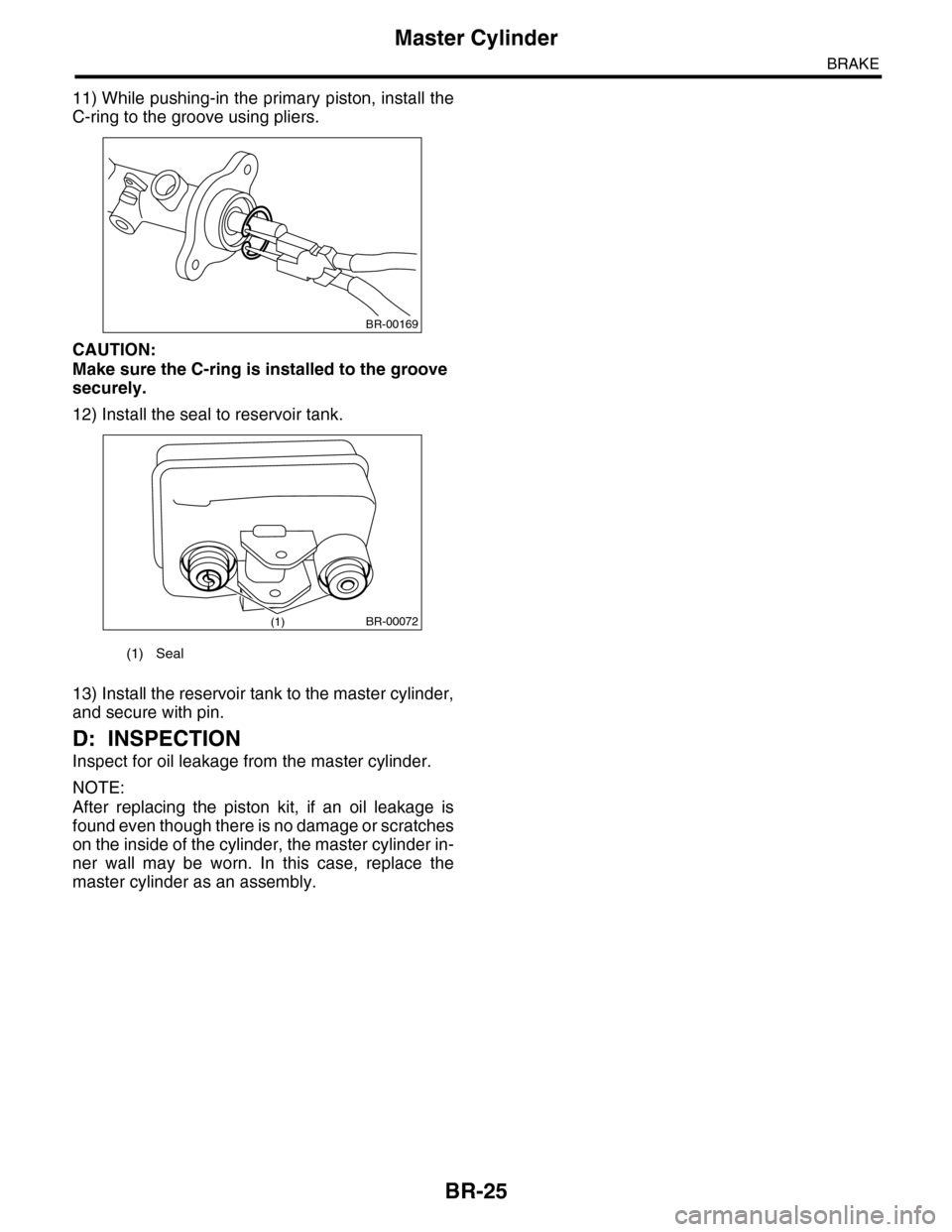
BR-25
Master Cylinder
BRAKE
11) While pushing-in the primary piston, install the
C-ring to the groove using pliers.
CAUTION:
Make sure the C-ring is installed to the groove
securely.
12) Install the seal to reservoir tank.
13) Install the reservoir tank to the master cylinder,
and secure with pin.
D: INSPECTION
Inspect for oil leakage from the master cylinder.
NOTE:
After replacing the piston kit, if an oil leakage is
found even though there is no damage or scratches
on the inside of the cylinder, the master cylinder in-
ner wall may be worn. In this case, replace the
master cylinder as an assembly.
(1) Seal
BR-00169
(1) BR-00072
Page 740 of 2453

BR-26
Brake Booster
BRAKE
9. Brake Booster
A: REMOVAL
1) Remove or disconnect the following parts in the
engine compartment.
(1) Remove the brake master cylinder.
(2) Disconnect the vacuum hose from brake
booster.
2) Remove the following parts from the pedal
bracket.
(1) Snap pin and clevis pin
(2) Four brake booster installation nuts
3) Remove the brake booster while avoiding the
brake pipe.
NOTE:
•Make sure that the booster shell and vacuum
pipe are not subject to strong impacts.
•Be careful not to drop the brake booster. If the
booster is dropped, replace it.
•Use special care when handling the operating
rod. If excessive force is applied to the operating
rod, the angle may change by ±3°, and it may result
in damage to power piston cylinder.
•Be careful when placing the brake booster on
floor.
•Do not change the push rod length.
CAUTION:
•Do not disassemble the brake booster.
•If external force is applied from above when
brake booster is placed in this position, the res-
in portion as indicated by “P” may become
damaged.
(1) Nut
(2) Clevis pin
(3) Snap pin
(4) Operating rod
(1)
(3)
(4)
(2)
BR-00073
(1) Force
(1)
P
BR-00075
Page 741 of 2453
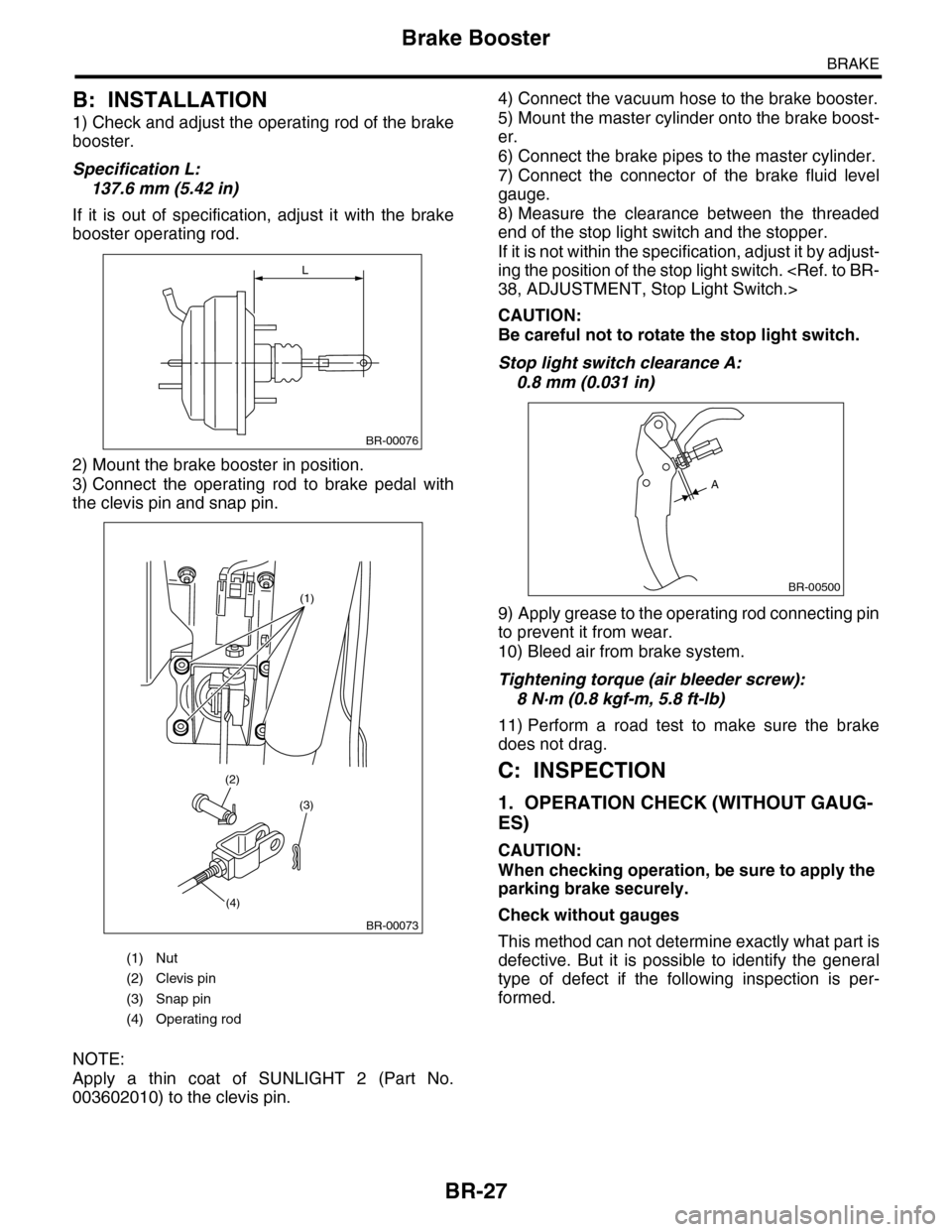
BR-27
Brake Booster
BRAKE
B: INSTALLATION
1) Check and adjust the operating rod of the brake
booster.
Specification L:
137.6 mm (5.42 in)
If it is out of specification, adjust it with the brake
booster operating rod.
2) Mount the brake booster in position.
3) Connect the operating rod to brake pedal with
the clevis pin and snap pin.
NOTE:
Apply a thin coat of SUNLIGHT 2 (Part No.
003602010) to the clevis pin.
4) Connect the vacuum hose to the brake booster.
5) Mount the master cylinder onto the brake boost-
er.
6) Connect the brake pipes to the master cylinder.
7) Connect the connector of the brake fluid level
gauge.
8) Measure the clearance between the threaded
end of the stop light switch and the stopper.
If it is not within the specification, adjust it by adjust-
ing the position of the stop light switch.
CAUTION:
Be careful not to rotate the stop light switch.
Stop light switch clearance A:
0.8 mm (0.031 in)
9) Apply grease to the operating rod connecting pin
to prevent it from wear.
10) Bleed air from brake system.
Tightening torque (air bleeder screw):
8 N·m (0.8 kgf-m, 5.8 ft-lb)
11) Perform a road test to make sure the brake
does not drag.
C: INSPECTION
1. OPERATION CHECK (WITHOUT GAUG-
ES)
CAUTION:
When checking operation, be sure to apply the
parking brake securely.
Check without gauges
This method can not determine exactly what part is
defective. But it is possible to identify the general
type of defect if the following inspection is per-
formed.
(1) Nut
(2) Clevis pin
(3) Snap pin
(4) Operating rod
L
BR-00076
(1)
(3)
(4)
(2)
BR-00073
BR-00500
A
Page 744 of 2453

BR-30
Brake Fluid
BRAKE
10.Brake Fluid
A: INSPECTION
1) Check that the brake fluid level is between “MIN”
and “MAX”. If out of the specified range, refill or
drain fluid. If the fluid level is close to “MIN”, check
the brake pad for wear and refill the fluid.
2) Check the fluid for discoloration. If the fluid color
has changed excessively, drain the fluid and refill
with new fluid.
B: REPLACEMENT
CAUTION:
•Do not let brake fluid come into contact with
the painted surface of the vehicle body. Wash
away with water immediately and wipe off if it is
spilled by accident.
•Avoid mixing brake fluids of different brands
to prevent fluid performance from degrading.
•Be careful not to allow dirt or dust to enter the
reservoir tank.
NOTE:
•During the operation, keep the reservoir tank
filled with brake fluid to eliminate entry of air.
•Operate the brake pedal slowly.
•For convenience and safety, perform work with 2
people.
•The required amount of brake fluid is approxi-
mately 600 m2 (20 US fl oz, 21 Imp fl oz) for entire
brake system.
1) Lift-up the vehicle and set rigid racks at the spec-
ified locations, or keep the vehicle lifted.
2) Remove both the front and rear wheels.
3) Drain brake fluid from the reservoir tank.
4) Refill the reservoir tank with the recommended
brake fluid.
Recommended brake fluid:
Refer to the specification.
Perform the same procedure as for bleeding the
brake line, until new brake fluid comes out from vi-
nyl tube.
NOTE:
Perform the brake fluid replacement starting in or-
der from the farthest wheel cylinder from the mas-
ter cylinder.
Page 745 of 2453

BR-31
Air Bleeding
BRAKE
11.Air Bleeding
A: PROCEDURE
CAUTION:
•Do not let brake fluid come into contact with
the painted surface of the vehicle body. Wash
away with water immediately and wipe off if it is
spilled by accident.
•Avoid mixing brake fluids of different brands
to prevent fluid performance from degrading.
•Be careful not to allow dirt or dust to enter the
reservoir tank.
1. MASTER CYLINDER
NOTE:
•When the master cylinder is disassembled or the
reservoir tank is empty, bleed the master cylinder.
•If bleeding of the master cylinder is not neces-
sary, omit the following procedures, and perform
bleeding of the brake line.
1) Fill the reservoir tank of the master cylinder with
brake fluid.
NOTE:
While bleeding air, keep the reservoir tank filled
with brake fluid to prevent entry of air.
2) Disconnect the brake line at primary and sec-
ondary sides.
3) Wrap the master cylinder with a plastic bag.
4) Depress the brake pedal slowly and hold it.
5) Plug the outlet plug with your finger, and then re-
lease the brake pedal.
6) Repeat the step 4) and 5) several times.
7) Remove the plastic bag.
8) Install the brake pipe to the master cylinder.
Tightening torque:
19 N·m (1.9 kgf-m, 14.0 ft-lb)
9) Bleed air from the brake line.
2. BRAKE LINE
1) When the master cylinder is disassembled or the
reservoir tank is empty, bleed the master cylinder
before bleeding the brake line.
ing.>
2) Fill the reservoir tank of the master cylinder with
brake fluid.
NOTE:
While bleeding air, keep the reservoir tank filled
with brake fluid to prevent entry of air.
3) Attach one end of the vinyl tube to the air bleeder
and the other end to the brake fluid container.
4) Depress the brake pedal several times, and
keep it pressed.
5) Loosen the air bleeder screw to drain brake fluid.
Tighten the air bleeder quickly, and release the
brake pedal.
6) Repeat the steps 4) to 5) until there are no more
air bubbles in the vinyl tube.
7) Repeat the steps from 2) to 6) above to bleed air
from each wheel.
NOTE:
Perform the operation in the order from closest
wheel cylinder to the master cylinder.
8) Securely tighten the air bleeder screws.
Tightening torque:
8 N·m (0.8 kgf-m, 5.8 ft-lb)
9) Check that there are no brake fluid leaks in the
entire system.
BR-00090
BR-00091
BR-00087
Page 755 of 2453
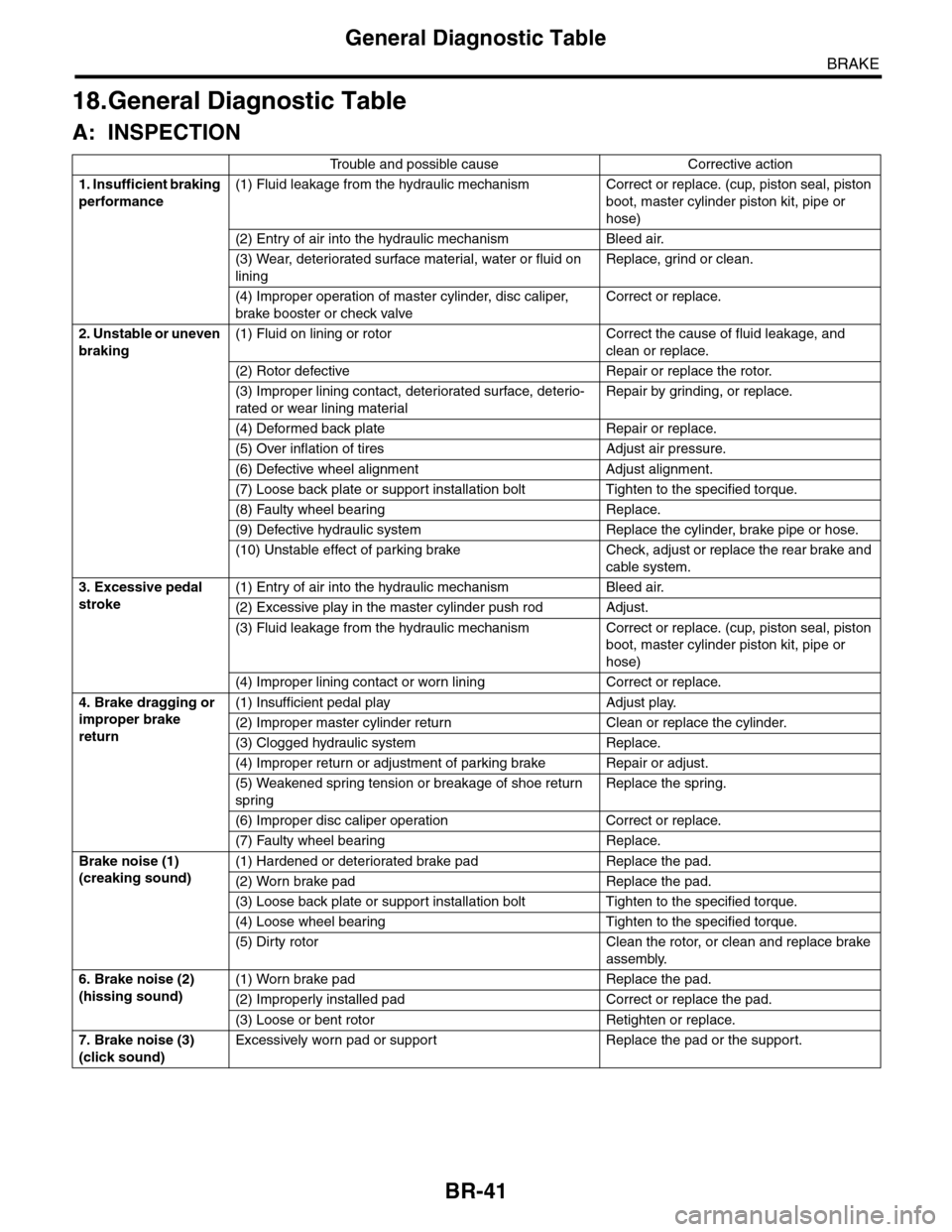
BR-41
General Diagnostic Table
BRAKE
18.General Diagnostic Table
A: INSPECTION
Trouble and possible causeCorrective action
1. Insufficient braking
performance
(1) Fluid leakage from the hydraulic mechanism Correct or replace. (cup, piston seal, piston
boot, master cylinder piston kit, pipe or
hose)
(2) Entry of air into the hydraulic mechanism Bleed air.
(3) Wear, deteriorated surface material, water or fluid on
lining
Replace, grind or clean.
(4) Improper operation of master cylinder, disc caliper,
brake booster or check valve
Correct or replace.
2. Unstable or uneven
braking
(1) Fluid on lining or rotor Correct the cause of fluid leakage, and
clean or replace.
(2) Rotor defective Repair or replace the rotor.
(3) Improper lining contact, deteriorated surface, deterio-
rated or wear lining material
Repair by grinding, or replace.
(4) Deformed back plate Repair or replace.
(5) Over inflation of tires Adjust air pressure.
(6) Defective wheel alignment Adjust alignment.
(7) Loose back plate or suppor t installation bolt Tighten to the specified torque.
(8) Faulty wheel bearing Replace.
(9) Defective hydraulic system Replace the cylinder, brake pipe or hose.
(10) Unstable effect of parking brake Check, adjust or replace the rear brake and
cable system.
3. Excessive pedal
stroke
(1) Entry of air into the hydraulic mechanism Bleed air.
(2) Excessive play in the master cylinder push rod Adjust.
(3) Fluid leakage from the hydraulic mechanism Correct or replace. (cup, piston seal, piston
boot, master cylinder piston kit, pipe or
hose)
(4) Improper lining contact or worn lining Correct or replace.
4. Brake dragging or
improper brake
return
(1) Insufficient pedal play Adjust play.
(2) Improper master cylinder return Clean or replace the cylinder.
(3) Clogged hydraulic system Replace.
(4) Improper return or adjustment of parking brake Repair or adjust.
(5) Weakened spring tension or breakage of shoe return
spring
Replace the spring.
(6) Improper disc caliper operation Correct or replace.
(7) Faulty wheel bearing Replace.
Brake noise (1)
(creaking sound)
(1) Hardened or deteriorated brake pad Replace the pad.
(2) Worn brake pad Replace the pad.
(3) Loose back plate or suppor t installation bolt Tighten to the specified torque.
(4) Loose wheel bearing Tighten to the specified torque.
(5) Dir ty rotor Clean the rotor, or clean and replace brake
assembly.
6. Brake noise (2)
(hissing sound)
(1) Worn brake pad Replace the pad.
(2) Improperly installed pad Correct or replace the pad.
(3) Loose or bent rotor Retighten or replace.
7. Brake noise (3)
(click sound)
Excessively worn pad or suppor t Replace the pad or the suppor t.